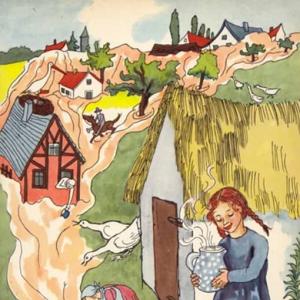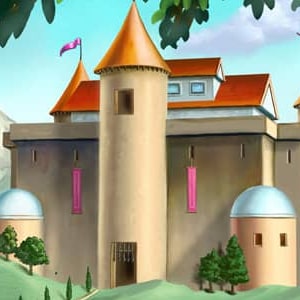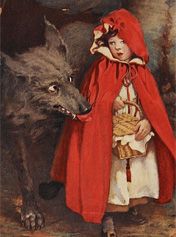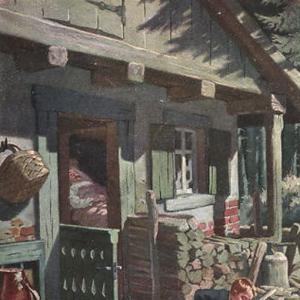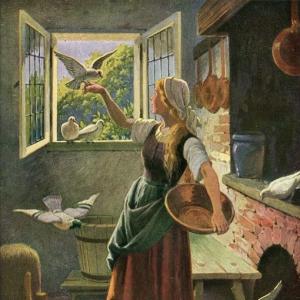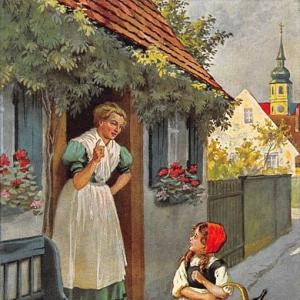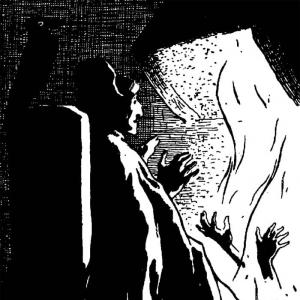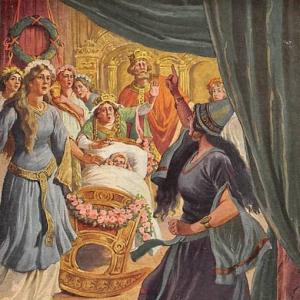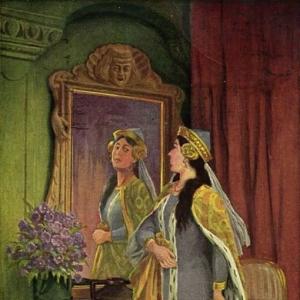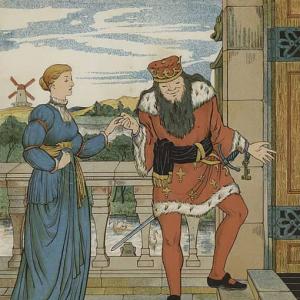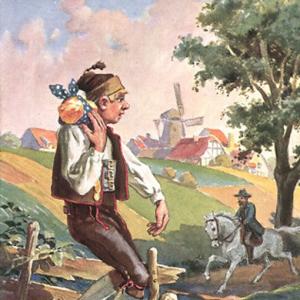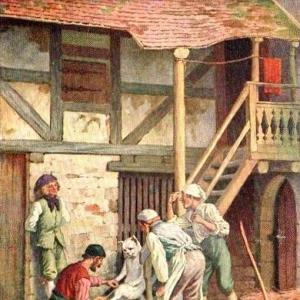Reading time: 7 min
In days gone by there was a land where the nights were always dark, and the sky spread over it like a black cloth, for there the moon never rose, and no star shone in the obscurity. At the creation of the world, the light at night had been sufficient. Three young fellows once went out of this country on a travelling expedition, and arrived in another kingdom, where, in the evening when the sun had disappeared behind the mountains, a shining globe was placed on an oak-tree, which shed a soft light far and wide. By means of this, everything could very well be seen and distinguished, even though it was not so brilliant as the sun. The travellers stopped and asked a countryman who was driving past with his cart, what kind of a light that was. „That is the moon,“ answered he; our mayor bought it for three thalers, and fastened it to the oak-tree. He has to pour oil into it daily, and to keep it clean, so that it may always burn clearly. He receives a thaler a week from us for doing it.“
When the countryman had driven away, one of them said, „We could make some use of this lamp, we have an oak-tree at home, which is just as big as this, and we could hang it on that. What a pleasure it would be not to have to feel about at night in the darkness!“ – „I’ll tell you what we’ll do,“ said the second; „we will fetch a cart and horses and carry away the moon. The people here may buy themselves another.“ – „I’m a good climber,“ said the third, „I will bring it down.“ The fourth brought a cart and horses, and the third climbed the tree, bored a hole in the moon, passed a rope through it, and let it down. When the shining ball lay in the cart, they covered it over with a cloth, that no one might observe the theft. They conveyed it safely into their own country, and placed it on a high oak. Old and young rejoiced, when the new lamp let its light shine over the whole land, and bed-rooms and sitting-rooms were filled with it. The dwarfs came forth from their caves in the rocks, and the tiny elves in their little red coats danced in rings on the meadows.
The four took care that the moon was provided with oil, cleaned the wick, and received their weekly thaler, but they became old men, and when one of them grew ill, and saw that he was about to die, he appointed that one quarter of the moon, should, as his property, be laid in the grave with him. When he died, the mayor climbed up the tree, and cut off a quarter with the hedge-shears, and this was placed in his coffin. The light of the moon decreased, but still not visibly. When the second died, the second quarter was buried with him, and the light diminished. It grew weaker still after the death of the third, who likewise took his part of it away with him; and when the fourth was borne to his grave, the old state of darkness recommenced, and whenever the people went out at night without their lanterns they knocked their heads together.
When, however, the pieces of the moon had united themselves together again in the world below, where darkness had always prevailed, it came to pass that the dead became restless and awoke from their sleep. They were astonished when they were able to see again. The moonlight was quite sufficient for them, for their eyes had become so weak that they could not have borne the brilliance of the sun. They rose up and were merry, and fell into their former ways of living. Some of them went to the play and to dance, others hastened to the public-houses, where they asked for wine, got drunk, brawled, quarreled, and at last took up cudgels, and belabored each other. The noise became greater and greater, and at last reached even to heaven.
Saint Peter who guards the gate of heaven thought the lower world had broken out in revolt and gathered together the heavenly troops, which are to drive back the Evil One when he and his associates storm the abode of the blessed. As these, however, did not come, he got on his horse and rode through the gate of heaven, down into the world below. There he reduced the dead to subjection, bade them lie down in their graves again, took the moon away with him, and hung it up in heaven.
 Learn languages. Double-tap on a word.Learn languages in context with Childstories.org and Deepl.com.
Learn languages. Double-tap on a word.Learn languages in context with Childstories.org and Deepl.com.Backgrounds
Interpretations
Adaptions
Summary
Linguistics
„The Moon“ is a lesser-known fairy tale by the Brothers Grimm, who were German academics, philologists, cultural researchers, and authors. The brothers, Jacob and Wilhelm Grimm, collected and published a collection of folktales and legends in the early 19th century, known as „Grimm’s Fairy Tales“ or „Children’s and Household Tales“ (originally „Kinder- und Hausmärchen“ in German). Their work played a significant role in popularizing and preserving traditional European folktales.
Born in the late 18th century, the Brothers Grimm were part of the German Romantic movement, which emphasized the importance of folklore, national identity, and the connection between the natural and spiritual worlds. Their fairy tales often contain moral lessons and explore themes such as good versus evil, the consequences of human actions, and the importance of courage and wisdom.
Some of the most famous stories from their collection include „Cinderella,“ „Snow White,“ „Hansel and Gretel,“ „Rapunzel,“ and „Little Red Riding Hood.“ While „The Moon“ may not be as widely known as these other tales, it still showcases the Brothers Grimm’s ability to create enchanting stories that captivate readers and convey deeper themes and messages.
„The Moon“ by Brothers Grimm can be interpreted in various ways, touching upon themes such as the human desire for knowledge and light, the consequences of greed, and the balance between life and death.
Human desire for knowledge and light: The story highlights the innate human curiosity and desire for enlightenment. The travelers, upon discovering the moon, are eager to bring light and knowledge to their people, showing how important these aspects are in human life.
Consequences of greed: The four men’s decision to steal the moon and subsequently take a quarter of it to their graves demonstrates the destructive nature of greed. Their selfish actions lead to the loss of light in their world and cause chaos in the underworld.
Balance between life and death: The story showcases the delicate balance between life and death, as the moon’s light brings joy to the living but unrest to the dead. Saint Peter’s intervention restores the natural order, illustrating the importance of maintaining harmony between different realms.
The role of authority and responsibility: The mayor in the neighboring kingdom took responsibility for maintaining the moon, providing light for his people. This can be seen as an allegory for the duties of leaders or governments in providing for the well-being of their citizens.
The transformative power of light: The moon’s light has the power to transform both the living and the dead, affecting their behavior and emotions. This highlights the profound impact that light, symbolizing knowledge, hope, and guidance, can have on individuals and communities.
„The Moon,“ a lesser-known fairy tale from the Brothers Grimm, has inspired a number of adaptations over the years. Here are some notable examples.
„Moon Man“ by Tomi Ungerer: This children’s book, published in 1966, tells the story of a man who lives on the moon and decides to visit Earth. The book was adapted into an animated film in 2012.
„The Moon and the Sun“ by Vonda N. McIntyre: This novel, published in 1997, is a science fiction retelling of „The Moon“ that takes place in the court of Louis XIV. The story involves a quest to capture a sea monster that may hold the key to immortality.
„La Luna“ by Pixar: This animated short film, directed by Enrico Casarosa, tells the story of a young boy who goes on a nighttime boat ride with his father and grandfather. The film explores themes of family, tradition, and the magic of the moon.
„The Moon Maiden“ by Roshani Chokshi: This young adult novel, published in 2022, is a reimagining of „The Moon“ that takes place in ancient India. The story follows a young woman named Priya who sets out on a dangerous journey to win the love of the moon.
„The Moon Prince“ by S.J. Tucker: This music album, released in 2019, features a collection of songs inspired by „The Moon.“ The album tells the story of a prince who falls in love with the moon and embarks on a journey to win her heart.
These adaptations demonstrate the enduring appeal of „The Moon“ and the many ways in which its themes and motifs can be reinterpreted for new audiences.
In „The Moon“ by Brothers Grimm, a land exists where nights are always dark, without the moon or stars. Three young men from this land venture into a neighboring kingdom where they discover a shining globe hanging from an oak-tree. They learn that this is the moon, bought by the mayor for three thalers, and maintained by him for a thaler a week. The travelers decide to steal the moon and bring it to their own land, where it provides light for everyone. The dwarfs and elves rejoice in its glow.
As the four men grow old, each decides to take a quarter of the moon to their grave. With each passing, the moon’s light diminishes, eventually plunging the land back into darkness. Meanwhile, in the underworld, the united moon quarters provide light for the dead. This newfound visibility causes unrest among them, leading to raucous behavior that disturbs heaven.
Saint Peter, guardian of heaven’s gate, believes the lower world is in revolt. He rides down to restore order, commanding the dead to return to their graves. Taking the moon with him, he hangs it up in heaven, restoring its light for the entire world.
The fairy tale „The Moon“ by the Brothers Grimm is a rich narrative filled with themes of theft, greed, and the cyclical nature of life and light.
Simple Narrative: The tale follows a straightforward plot structure typical of folk tales: introduction, complication, climax, and resolution.
Repetition: There is a repetitive structure in the story, especially with the moon being divided and the consequences that follow each division. It emphasizes the gradual loss of light and the subsequent repercussions.
Chronological Order: Events unfold in a linear fashion, making the narrative easy to follow.
Language
Descriptive Imagery: The dark land, the shining moon, and the awakening dead are described in vivid detail, supporting the magical and eerie atmosphere.
Dialogue: The use of dialogue among the four characters and the countryman adds a conversational tone, moving the plot forward and highlighting the characters’ intentions and actions.
Symbolism
The Moon: A central symbol representing not only light but also knowledge, life, and community well-being. Its theft leads to unintended consequences, reflecting human flaws.
Darkness and Light: Darkness symbolizes ignorance and chaos, while light from the moon signifies clarity, guidance, and order.
Personification: The moon and other natural elements often take on human qualities, which is a common device in fairy tales to imbue moral or ethical considerations.
Themes
Greed and Consequences: The story illustrates how the characters‘ selfish desires lead to societal loss, highlighting the theme that greed can blind individuals to broader implications.
Mortality and Legacy: As each of the four characters die, they take a part of the moon with them, symbolizing how one’s legacy can affect the community.
Restoration and Order: The intervention of Saint Peter symbolizes divine or moral order, restoring balance by returning the moon to its rightful place.
Characterization
The Four Travellers: They represent human characteristics of ambition and imprudence. Their plan, although initially successful, eventually demonstrates their short-sightedness.
Saint Peter: Represents authority and order, bringing resolution to the chaos caused by human folly.
Moral and Ethical Lessons: The tale underscores the importance of respecting natural order and the folly of human egotism. It serves as a cautionary tale about the repercussions of actions driven by greed.
In conclusion, „The Moon“ uses a blend of vivid imagery, dialogic exchanges, and symbolic elements to convey its themes, making it a rich object of study for understanding human nature through the lens of folklore.
Information for scientific analysis
Fairy tale statistics | Value |
|---|---|
| Number | KHM 175 |
| Translations | DE, EN, DA, ES, FR, PT, IT, JA, NL, PL, RU, TR, VI, ZH |
| Readability Index by Björnsson | 36.1 |
| Flesch-Reading-Ease Index | 76.1 |
| Flesch–Kincaid Grade-Level | 8.7 |
| Gunning Fog Index | 11.7 |
| Coleman–Liau Index | 8.4 |
| SMOG Index | 9.3 |
| Automated Readability Index | 10.2 |
| Character Count | 4.159 |
| Letter Count | 3.227 |
| Sentence Count | 32 |
| Word Count | 786 |
| Average Words per Sentence | 24,56 |
| Words with more than 6 letters | 91 |
| Percentage of long words | 11.6% |
| Number of Syllables | 983 |
| Average Syllables per Word | 1,25 |
| Words with three Syllables | 36 |
| Percentage Words with three Syllables | 4.6% |
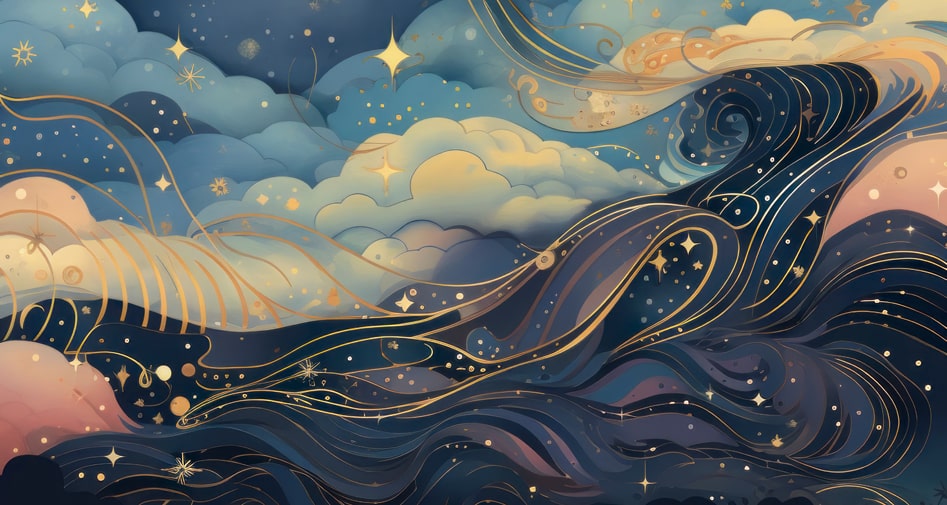
 Facebook
Facebook  Whatsapp
Whatsapp  Messenger
Messenger  Telegram
Telegram Reddit
Reddit
